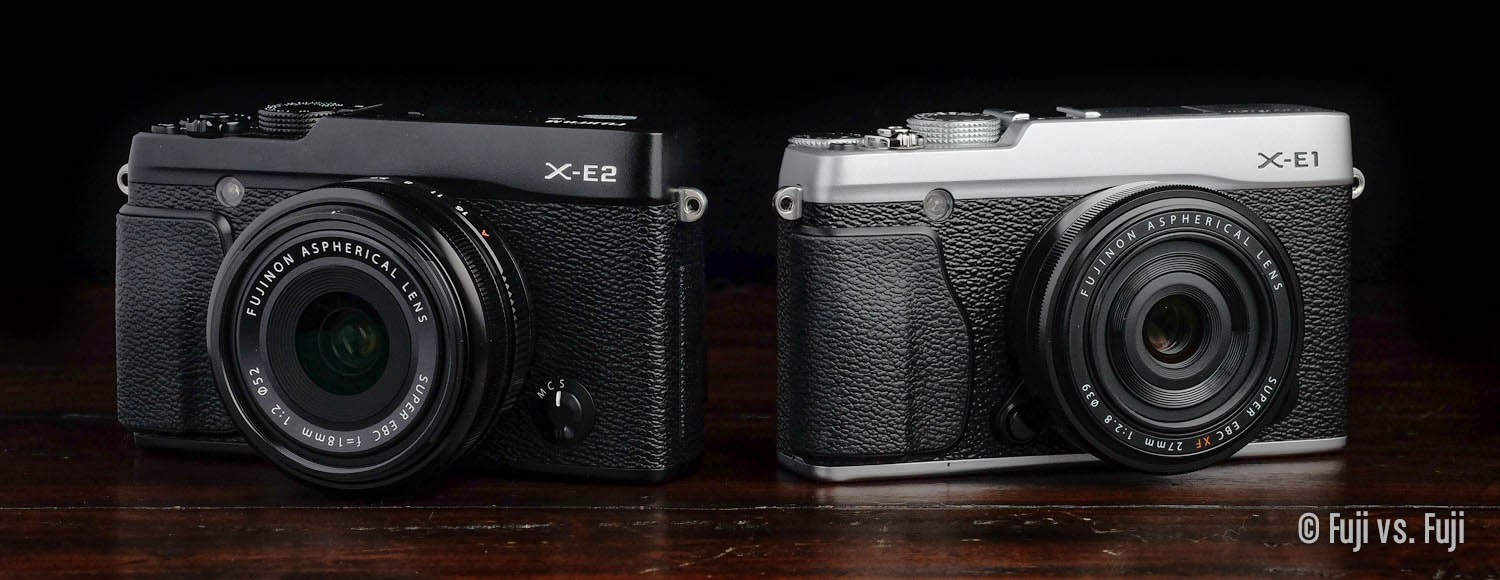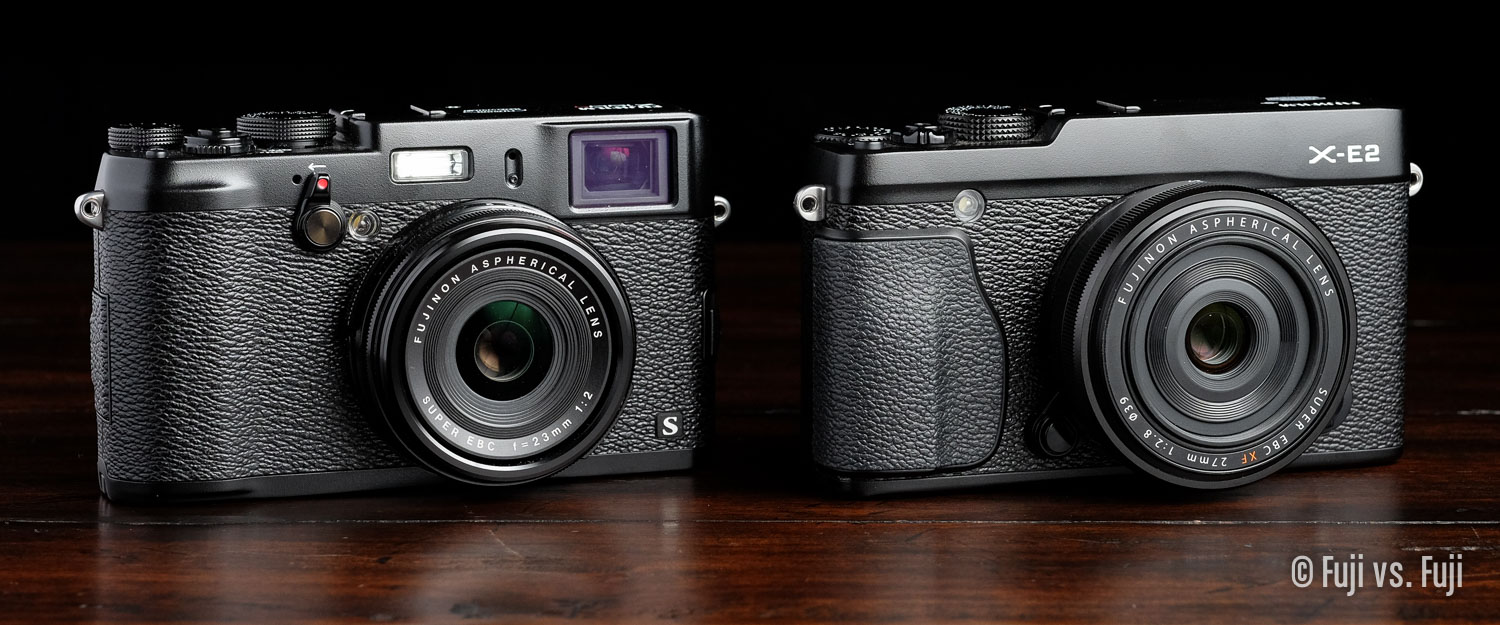Fuji XF 18mm F/2 vs. XF 27mm F/2.8, a comparison between Fuji’s smallest wide angle prime and “pancake” lens.
Introduction
The 18mm f/2 and the 27mm f/2.8 are the smallest lenses in Fujifilm’s lineup by a fairly wide margin. While the two are very different as far as focal length is concerned, their similar size is reason enough for this comparison to exists. It's also a regular seach term that people land on my site with.
If you’d like to purchase one of these lenses, or anything else for that matter, please consider using one of the Amazon affiliate links below. The price is the same for you, but a small percentage of the purchase price goes to me, which helps keep this site going. Thank you.
Specifications
| XF 18mm F/2 | XF 27mm F/2.8 | |
|---|---|---|
| Announced | January 9, 2012 | June 26, 2012 |
| Released | February, 2012 | July, 2013 |
| Price (MSRP) |
$599 | $449 |
| Lens Construction | 8 elements in 7 groups 2 aspherical elements |
7 elements in 5 groups 1 aspherical element |
| 35mm Equivalent | 27.36mm | 41mm |
| Angle of View | 76.5° | 55.5° |
| Aperture Range | f/2 - f/16 | f/2.8 - f/16 |
| Focus Range | 0.8m (18cm Macro) - ∞ (Infinity) | 0.6m (34cm Macro) - ∞ (Infinity) |
| Maximum Magnification | 0.14x | 0.1x |
| External Dimensions | 64.5mm diameter x 33.7mm | 61.2mm diameter x 23mm long |
| Weight (Measured) | 118g 138g with caps 149.5g with caps and hood |
77g |
| Filter Size | 52mm | 39mm |
Handling
Aperture ring
Despite these lenses being so close in size, they couldn’t handle more differently. The reason for this is the 27mm f/2.8 sadly lacks an aperture ring. Fujifilm teased us with this lens prior to its official introduction and release as early prototypes had an aperture ring included. It’s a real shame they decided to exclude it as it really does make the 27mm f/2.8 an odd lens out, and affects my desire to use it on a regular basis. Whenever I mount the lens I usually have forgotten which dial on my X-T1 controls the aperture (it’s the rear one, I think). Changes like that seem trivial on paper, but they make using the lens take just enough extra cognitive effort for it to be mildly frustrating. I’d love to see Fuji reissue this lens with the aperture ring as we once saw it.
Hood
An aperture ring isn’t the only thing the 27mm f/2.8 is missing compared to the 18mm f/2. A hood is also strangely absent from the box. Given the 27mm f/2.8’s positively tiny filter size though, it would be a small and strange looking hood. Perhaps a second bayonet ring could have been added to the perimeter of the lens, but the point is you may need to be mindful of flare while using it. I haven’t found it to be a big problem so far though.
Size and weight
Regular visitors will know I’m a tad obsessive when it comes to weight-savings. If you want the absolute lightest camera package possible, either of these lenses will do it for you. Take your pick, mount them on an X-E body (or and X-M body for that matter), and you’ll have a camera that’s almost as light, if not lighter than the X100(S), and—especially with the 27mm f/2.8 mounted—only a little bit larger.
Despite this, I would still opt for an X100S over just about any camera with the 27mm f/2.8. With a camera as fast as the X-T1, it’s a tougher choice as the slower pace of the X100S’s AF system can really be felt when coming from the X-T1. That should be resolved once that X100T comes out though.
When it comes to the 18mm f/2, I really enjoy having that lens on any camera, however I might still opt for and X100 camera with the WCL-X100 instead as I’m finding that optically it really holds its own compared to the 18mm f/2. Between the two though, I’d reach for the 18mm f/2 ahead of the 27mm f/2.8 almost every time.
XF 18mm f/2 Weight Compared
XF 27mm f/2.8 Weight Compared
Focal length
These lenses are different enough in field of view that outside of their small size, it really makes little sense to make a thorough comparison between them. If you want something wide, go for the 18mm f/2. It’s wide enough that you can easily take an environmental portrait of someone without them even knowing it. If you’re looking for more of a “normal” focal length and size is absolutely paramount, grab the 27mm f/2.8. Otherwise, I’d go for the 35mm f/1.4. Without a hood it’s plenty small.
While it’s fantastic that Fuji is building us a thoroughly complete set of primes—and at a breakneck pace—both of these lenses have and/or will have close alternatives that overall are superior in most ways. As mentioned above, I would never grab the 27mm f/2.8 over the 35mm f/1.4 unless size and discretion were the most important deciding factors. On an X-E or X-M body, the 27mm f/2.8 can really help to disarm people in public places. With the 18mm f/2, I’d always go for the 14mm f/2.8 for landscape shooting, and I’ll soon take the 16mm f/1.4 when I want a fast wide angle lens. It really is size and weight that makes these lenses a viable option.
Sharpness
Both lenses are capable of producing adequately sharp results. At pixel peeping level and out to the corners, the 27mm f/2.8 is the stronger performer in my experience.
Distortion
The 18mm f/2 is Fuji’s most distortion-laden lens. For straight lines and horizons, look elsewhere. Corrected JPEGs out of the camera still show some distortion, and with uncorrected RAFs, the distortion is objectionably heavy. Even the fantastic 10-24mm f/4 zoom has much less distortion as shown in my Versus article. The 27mm f/2.8 has some barrel distortion to it as well, but it’s corrected into oblivion in-camera. The 27mm f/2.8 gets the nod here too.
Bokeh!
Wider angles aren’t typically the place for smooth bokeh, but the 18mm f/2 does quite well in this department. For environmental portraits, a good amount of background separation is really easy to achieve. This will be one area that will be particularly interesting for me to compare once the 16mm f/1.4 hits. The 27mm f/2.8 delivers decent bokeh, but it’s actually quite slow when compared to something like the 35mm f/1.4 which renders gorgeous out of focus backgrounds. I’d hand this one to the 18mm ƒ/2.
Conclusion
If I didn’t have this site to run and maintain, I doubt I’d have ever purchased the 27mm f/2.8. I’m pleased this site has given me an excuse to try it because it can come in handy when discretion is paramount. For me though, the handling inconsistencies and focal length similarities mean it’s used very little. If it was one of the few lenses I owned, it would see a lot more use and I’d be very satisfied with the quality it delivers overall. Yes, it’s a little on the slow side, but that’s what a ridiculously small lens gets you.
The 18mm f/2 was a bit of a curiousity purchase for me as well. I already had the 14mm f/2.8, but it can easly get too wide for environmental portraits. Edge distortion can make humans look weird. The 18mm f/2 strikes and great balance. People on the outside of the frame won’t know they’re being photographed and the distortion isn’t too great outside of the outermost reaches of the frame. The faster f/2 aperture also helps for lowlight and night shooting.
Additionally, there are some optimization strategies to consider here as well. It’s no mistake that both the 18mm f/2 and 35mm f/1.4 share the same 52mm filter thread. These two lenses cover a great range and you’ll only need one set of filters. The same goes for the 27mm f/2.8 and 60mm f/2.4 Macro, which both share a 39mm filter and 39mm filters are about as inexpensive (and adorable) as they come.
So while I don’t think either lens will find a steady home in my bag, they each can serve a purpose. Both lenses are optically good performers, and when you want to grab a nice light package and just go shoot, they can’t be beat on the interchangeable side of Fuji’s lineup.















